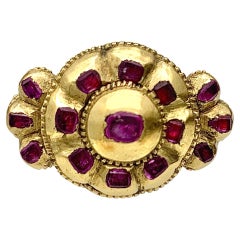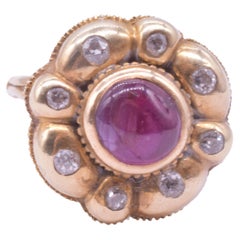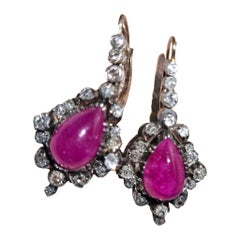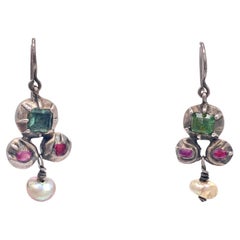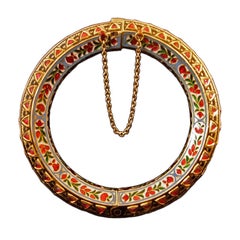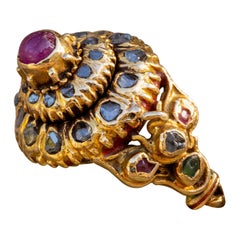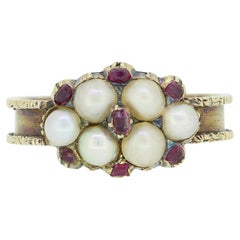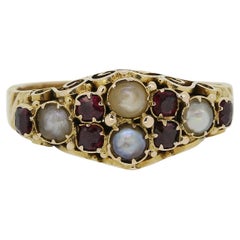18th Century Ruby
Antique 1750s Italian Dome Rings
Ruby, Gold, 18k Gold
Antique 1790s Spanish Baroque Cluster Rings
Diamond, Ruby, 18k Gold
Antique Late 18th Century European Georgian Drop Earrings
Diamond, Ruby, 18k Gold, Silver
Antique 1760s European Dangle Earrings
Emerald, Pearl, Ruby, Silver
Antique 1760s European Georgian Pendant Necklaces
Emerald, Natural Pearl, Ruby, Pearl, Silver
Antique Late 18th Century Indian Bangles
Diamond, Ruby, 22k Gold, Gold, Enamel
Antique Late 18th Century Thai More Rings
Diamond, Emerald, Ruby, 22k Gold
Antique 18th Century Georgian Cluster Rings
Pearl, Ruby, Gold
Antique 18th Century Cluster Rings
Pearl, Ruby, Gold, Yellow Gold
Antique 18th Century Georgian Link Bracelets
Emerald, Pearl, Ruby, 15k Gold, Yellow Gold
Antique 18th Century Georgian Cluster Rings
Pearl, Ruby, 9k Gold, Yellow Gold
Antique Late 18th Century Italian Georgian Cluster Rings
Ruby, Gold
Antique 18th Century Georgian Cluster Rings
Diamond, Emerald, Ruby, Sapphire, Gold, 15k Gold, Yellow Gold
Antique 18th Century Georgian Cocktail Rings
Diamond, Ruby, 18k Gold
Antique Late 18th Century Spanish Georgian Cluster Rings
Ruby, 18k Gold
Antique Early 18th Century Cocktail Rings
Diamond, Ruby, Platinum
Antique Late 18th Century Unknown Georgian Dangle Earrings
Diamond, Pearl, Ruby, 14k Gold, Yellow Gold
Antique 18th Century Unknown Victorian Three-Stone Rings
Diamond, Ruby, Sapphire, Yellow Gold
Antique Late 18th Century Unknown Victorian Fashion Rings
Diamond, Ruby, Yellow Gold
Antique Mid-18th Century European Renaissance Revival Brooches
Diamond, Ruby, 10k Gold, Silver
Antique 18th Century Georgian Brooches
Emerald, Opal, Sapphire, Gold, 14k Gold, Silver
Antique Late 18th Century French Art Deco Pocket Watches
Rose Gold
Antique Mid-18th Century Brooches
Gold, 18k Gold, Yellow Gold
Antique Early 18th Century Spanish Georgian Choker Necklaces
Diamond, Emerald, Ruby, Silver
Antique 18th Century Indian Boxes and Cases
Diamond, Emerald, Jade, Ruby, Blue Sapphire, Gold
Antique Early 18th Century Unknown Victorian Brooches
Diamond, Emerald, Ruby, Sapphire, Turquoise, 18k Gold, Silver
Antique Early 18th Century Unknown Georgian Brooches
Diamond, Ruby, Gold
Antique Late 18th Century Georgian Engagement Rings
Diamond, Ruby, Turquoise, 15k Gold
Antique Mid-18th Century Contemporary Brooches
Diamond, Ruby, 18k Gold, Yellow Gold
Antique 18th Century Unknown Victorian Engagement Rings
Diamond, Ruby, 18k Gold, Yellow Gold
Antique 18th Century and Earlier Italian Contemporary Drop Necklaces
Garnet, Ruby, Sapphire, 18k Gold
Antique 1850s Brooches
Ruby, Sapphire, Gilt Metal, Silver
Antique Late 18th Century Georgian More Rings
Ruby, 15k Gold
Antique 18th Century More Rings
Diamond, Ruby
Antique Mid-18th Century Engagement Rings
Diamond, Ruby, Gold
Antique Mid-18th Century Fashion Rings
White Diamond, Ruby, 18k Gold, White Gold
Antique 18th Century American Victorian Pendant Necklaces
Diamond, Ruby, Gold
Antique Late 18th Century European Rococo Solitaire Rings
Diamond, Ruby, 14k Gold, Silver
Antique Mid-18th Century British Georgian Engagement Rings
Diamond, Emerald, Ruby, 18k Gold, Silver
Antique Early 19th Century British Georgian Cluster Rings
Diamond, Ruby, Sterling Silver, 18k Gold
Antique Early 18th Century British Georgian Brooches
Emerald, Ruby, Gold, White Gold, Yellow Gold
Antique Mid-18th Century Italian Art Nouveau More Necklaces
Ruby, Blue Sapphire, 14k Gold, 18k Gold, 22k Gold
Antique Late 18th Century English Georgian Cluster Rings
Amethyst, Diamond, Emerald, Garnet, Ruby, 15k Gold
Antique Mid-18th Century Indian Cuff Bracelets
Ruby, Diamond, Emerald, 24k Gold
Antique Late 18th Century Indian Pendant Necklaces
Diamond, Emerald, Pearl, Ruby, 24k Gold
Antique Mid-18th Century Georgian Cocktail Rings
Diamond, Emerald, Ruby, Sapphire, Gold, Silver
Antique Early 18th Century English Georgian More Jewelry
Ruby, 18k Gold
Antique Late 18th Century Portuguese Brooches
Diamond, Emerald, Ruby, 18k Gold, Silver
Antique Mid-18th Century Indian Multi-Strand Necklaces
Diamond, Emerald, Natural Pearl, Ruby, Yellow Sapphire, 24k Gold
Antique 18th Century and Earlier Italian Artist Cocktail Rings
Diamond, Ruby, 18k Gold
Antique 18th Century and Earlier Italian Artist Cocktail Rings
Diamond, Ruby, 18k Gold
Antique 1780s British Fashion Rings
White Diamond, Ruby, 18k Gold
Antique 18th Century and Earlier Baroque Enamel Frames and Objects
Pearl, Ruby, Sapphire, Enamel, Gold Plate, Silver
Antique Late 18th Century French Neoclassical Pendant Necklaces
Diamond, Ruby, Gold, 18k Gold
Antique 18th Century Georgian Pendant Necklaces
Ruby
Antique Late 18th Century Unknown Victorian Band Rings
Diamond, Ruby, 18k Gold
Antique 18th Century Georgian Link Bracelets
Peridot, Ruby, 14k Gold
Antique Late 18th Century Indian Boxes and Cases
Gold
Antique 18th Century Victorian More Bracelets
Ruby, Turquoise
Antique Mid-18th Century Unknown Georgian Pendant Necklaces
Diamond, Ruby
- 1
18th Century Ruby For Sale on 1stDibs
How Much is a 18th Century Ruby?
Why Gold Shines in Jewelry Craftsmanship
Gold is the feel-good metal, the serotonin of jewelry. Wear vintage and antique gold necklaces, watches, gold bracelets or gold rings and you feel happy, you feel dressed, you feel, well, yourself.
Gold, especially yellow gold, with its rich patina and ancient pedigree going back thousands of years, is the steady standby, the well-mannered metal of choice. Any discussion of this lustrous metal comes down to a basic truth: Gold is elementary, my dear. Gold jewelry that couples the mystique of the metal with superb design and craftsmanship achieves the status of an enduring classic. Many luxury houses have given us some of our most treasured and lasting examples of gold jewelry over the years.
Since its founding, in 1837, Tiffany & Co. has built its reputation on its company jewelry as well as its coterie of boutique designers, which has included Jean Schlumberger, Donald Claflin, Angela Cummings and Elsa Peretti. There are numerous gold Tiffany classics worth citing. Some are accented with gemstones, but all stand out for their design and the workmanship displayed.
For the woman who prefers a minimalist look, the Tiffany & Co. twist bangle (thin, slightly ovoid) is stylishly simple. For Cummings devotees, signature pieces feature hard stone inlay, such as her pairs of gold ear clips inlaid with black jade (a play on the classic Chanel black and tan), or bangles whose design recalls ocean waves, with undulating lines of lapis lazuli and mother-of-pearl. And just about any design by the great Jean Schlumberger is by definition a classic.
Even had he eschewed stones and diamonds, Southern-born David Webb would be hailed for the vast arsenal of heavy gold jewelry he designed. Gold, usually hammered or textured in some manner, defines great David Webb jewelry. The self-taught jeweler made very au courant pieces while drawing inspiration from ancient and out-of-the-way sources — East meets West in the commanding gold necklaces made by Webb in the early 1970s. The same could be said for his endlessly varied gold cuffs.
In Europe, many houses have given us gold jewelry that sets the highest standard for excellence, pieces that were highly sought after when they were made and continue to be so.
Numerous designs from Cartier are homages to gold. There are the classic Trinity rings, necklaces and bracelets — trifectas of yellow, white and rose gold. As a testament to the power of love, consider the endurance of the Cartier Love bracelet.
Aldo Cipullo, Cartier’s top in-house designer from the late 1960s into the early ’70s, made history in 1969 with the Love bracelet. Cipullo frequently said that the Love bracelet was born of a sleepless night contemplating a love affair gone wrong and his realization that “the only remnants he possessed of the romance were memories.” He distilled the urge to keep a loved one close into a slim 18-karat gold bangle.
BVLGARI and its coin jewelry, gemme nummarie, hit the jackpot when the line launched in the 1960s. The line has been perennially popular. BVLGARI coin jewelry features ancient Greek and Roman coins embedded in striking gold mounts, usually hung on thick link necklaces of varying lengths. In the 1970s, BVLGARI introduced the Tubogas line, most often made in yellow gold. The Tubogas watches are classics, and then there is the Serpenti, the house's outstanding snake-themed watches and bracelets.
A collection called Monete that incorporated the gold coins is one of several iconic BVLGARI lines that debuted in the 1970s and ’80s, catering to a new generation of empowered women. Just as designers like Halston and Yves Saint Laurent were popularizing fuss-free ready-to-wear fashion for women on the go, BVLGARI offered jewels to be lived in.
Since Van Cleef & Arpels opened its Place Vendôme doors in 1906, collection after collection of jewelry classics have enchanted the public. As predominantly expressed in a honeycomb of gold, there is the Ludo watch and accessories, circa the 1920s, and the golden Zip necklace, 1951, whose ingenious transformation of the traditional zipper was originally proposed by the Duchess of Windsor. Van Cleef's Alhambra, with its Moroccan motif, was introduced in 1968 and from the start its popularity pivoted on royalty and celebrity status. It remains one of VCA’s most popular and collected styles.
Mention must be made of Buccellati, whose name is synonymous with gold so finely spun that it suggests tapestry. The house’s many gold bracelets, typically embellished with a few or many diamonds, signified taste and distinction and are always in favor on the secondary market. Other important mid-20th-century houses known for their gold-themed jewelry include Hermès and Ilias Lalaounis.
Find a stunning collection of vintage and antique gold jewelry on 1stDibs.
- 1stDibs ExpertApril 5, 2022Yes, wedding rings have a long history, stretching back to ancient Egypt. The first diamond engagement ring was created in 1477 by Archduke Maximillian of Austria. Browse a wide array of vintage and contemporary wedding rings on 1stDibs.
- 1stDibs ExpertApril 5, 2022In the 18th century, art changed in style from Baroque to Rococo and Neoclassicism. Art became more ornamented and idealized during the Rococo period and then shifted toward a style that emulated the artwork of ancient Greece and Rome near the end of the century. You’ll find a variety of fine art on 1stDibs.
- 1stDibs ExpertNovember 13, 2024To identify 18th-century furniture, you can research your piece in the context of the prevailing styles of the period or consult a certified appraiser or experienced antique dealer. To identify your item on your own, look over it for maker's marks, such as carvings, stamps, brands and labels. Researching the marking can help you determine the maker of your piece, and from there, you can search further to learn more about your particular item. Without a maker's mark, the best approach is to consider the characteristics of the dominant furniture styles during the 18th century. In England, these included William and Mary, Queen Anne, Georgian, Chippendale, Hepplewhite and Sheraton. Some French furniture styles of the 1700s include Louis XV, Louis XVI and Régence. Find a diverse assortment of 18th-century furniture on 1stDibs.
- 1stDibs ExpertApril 5, 2022One way to check if your brass candlesticks are from the 18th century is to look for the two seams running lengthwise on either side. This is from when the candlestick was molded in two halves and then soldered together. You’ll find a variety of candlesticks of all shapes and sizes from some of the top sellers on 1stDibs.
- 1stDibs ExpertJanuary 10, 2025The individuals considered the Big Three of 18th-century cartoons are William Hogarth, James Gillray and George Cruikshank. Although the 18th century saw a widespread increase in illustrations in newspapers, these three illustrators were particularly well-known for their work. Hogarth's work was extremely diverse, ranging from serious, realistic paintings and portraits to satirical and moralistic illustrations filled with symbolism. A British caricaturist, Gillray is remembered today for his artworks representing political and social satires, like his political cartoons against George III of England. Despite being a prolific caricaturist, Cruikshank is now most famous for illustrating the works of Charles Dickens. On 1stDibs, find a wide variety of illustrations.
- 1stDibs ExpertMarch 22, 2022Yes, there were cannons in the 16th century. The history of the weapon dates back to 12th-century China. Historical records suggest that the first cannons appeared in Europe during the Islamic wars in Iberia in the 13th century. Find a range of antique cannons on 1stDibs.
- 1stDibs ExpertApril 5, 2022Yes, the history of glass-making goes back much further than the 1600s. It’s believed that they were making glass in different parts of the world at least 3,600 years ago, maybe even longer. During the late Bronze Age in Egypt and in Western Asia, glassmarking advanced significantly and was manipulated extensively to produce vessels, jewelry, and works of art. Shop a range of antique and vintage glass on 1stDibs.
- 1stDibs ExpertApril 5, 2022At the end of the 17th century, Europe went into a frenzy over porcelain. Asian porcelain was highly sought after, and spurred the foundation of the Meissen factory in France, where hard porcelain went on to be made. You’ll find a large collection of porcelain pieces from many of the world’s top sellers on 1stDibs.
- 1stDibs ExpertApril 5, 2022What painting is the most important of the 20th century is largely a matter of personal opinion. Some notable works produced during the period include Paul Cézanne's Mont Sainte-Victoire, Pablo Picasso's Les Demoiselles d'Avignon, Henri Matisse's The Dance and Jackson Pollock's Lavender Mist. Shop a large selection of 20th-century paintings on 1stDibs.
- 1stDibs ExpertApril 5, 2022A variety of furniture was used during the 16th century. Items commonly found in homes include high-backed armchairs, chests, stools, benches and cupboards. Most European artisans active during the time period produced pieces out of oak wood. Find a large collection of antique furniture on 1stDibs.
- 1stDibs ExpertSeptember 23, 2024What 17th-century furniture is called varies. The general term for all furniture produced 100 years ago, including 17th-century pieces, is antique furniture. You may also choose to be more specific and describe a piece by its style. Theatrical and lavish, the Baroque style was prevalent across Europe from the 17th to the mid-18th century and spread around the world through colonialism, including in Asia, Africa and the Americas. Baroque furniture was extravagant in all aspects, from shape to materials. 17th-century pieces from England often feature characteristics of the William and Mary style, such as crisp lines, maple and walnut veneers, inlaid bands and C-scroll ornaments. On 1stDibs, explore a variety of antique furniture.
- 1stDibs ExpertApril 5, 2022Sir Isaac Newton invented the reflector telescope in the 17th century. He created it as a replacement for the refracting telescope, which tended to have poor optics. Find a collection of antique and vintage telescopes on 1stDibs from some of the world’s top sellers.
- 1stDibs ExpertApril 5, 2022British artist John Singer Sargent was one of the most important portrait painters of the 19th century. Other notable portraitists from the period include James Abbott McNeill Whistler, Eugène Delacroix, Théodore Géricault, Gustave Courbet, Édouard Manet, Mary Cassat, Claude Monet and Pierre-Auguste Renoir. On 1stDibs, find a wide variety of portrait paintings.
- 1stDibs ExpertApril 5, 202217th-century Dutch portraiture has many similarities to other Baroque paintings, including rich colors, dark shadows and intense lighting. Many famous Dutch Baroque works lean toward realism. In Dutch portraiture, props and detailed backgrounds are uncommon. You'll find a collection of Dutch Baroque paintings from some of the world’s top art dealers on 1stDibs.
- 1stDibs ExpertApril 5, 2022The French painters of the 19th century worked in two styles. Neoclassicism dominated the first half of the century, and Impressionism was the most common style during the second half. On 1stDibs, you can find a variety of French paintings.
